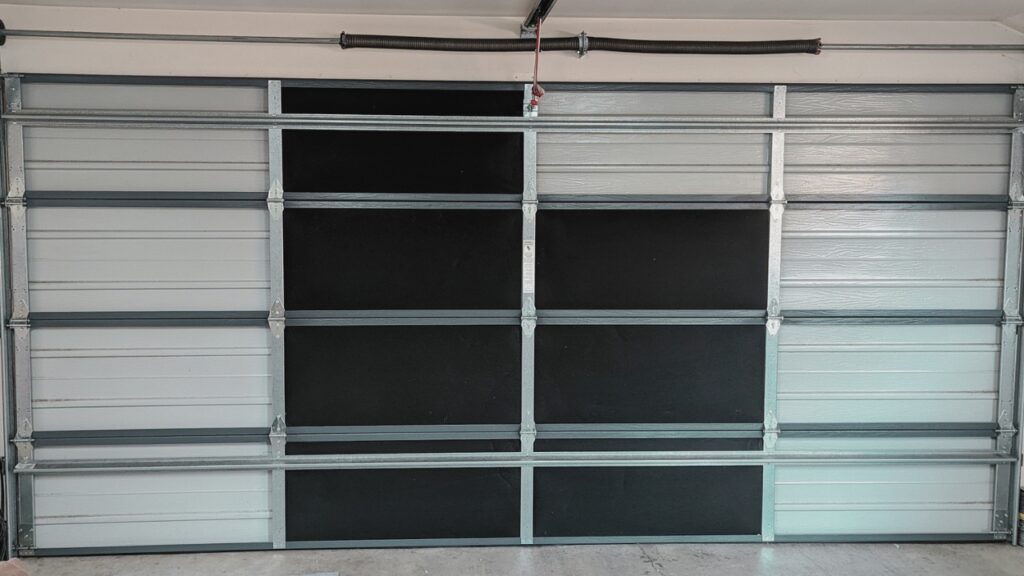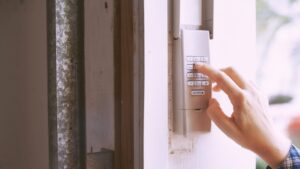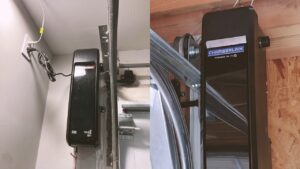Insulating your garage combats high energy bills and ensures comfort, but choosing the right insulation can be overwhelming. This guide simplifies your decision, comparing insulation types on cost, effectiveness, and longevity. It also includes a step-by-step DIY insulation tutorial.
Why Should I Insulate My Garage?
If you have an attached garage in an area prone to extreme temperatures, insulating it can significantly improve your quality of life.
An attached garage shares a wall with the rest of your home. If your garage becomes too hot or cold, you’ll also feel the effects inside your house.
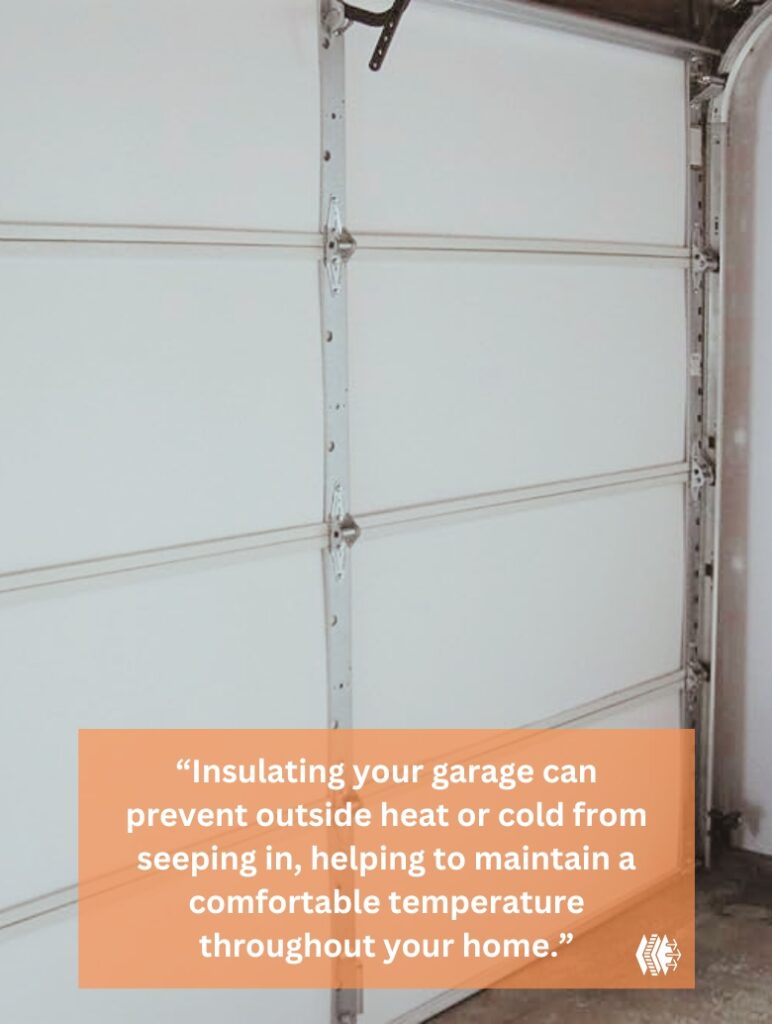
Insulating your garage can prevent outside heat or cold from seeping in, helping to maintain a comfortable temperature throughout your home. Insulation enhances comfort and reduces energy costs since your heating or cooling systems must work harder to regulate garage temperature.
In essence, insulating your garage creates a comfortable environment for both leisure and storage, ensuring you can enjoy your space regardless of outdoor conditions.
However, if you live in a region with moderate temperatures or have a detached garage used solely for parking, insulating may not be a worthwhile investment. Additionally, if your garage door remains open frequently or you utilize the space sparingly, the insulation benefits may not justify the expense.
Consider your garage type and what you want to do with it, then decide whether to insulate it. Think whether the potential benefits justify its cost.
Connect With A Garage Expert
Connect with local experts, Compare quotes, Get the best price.
Benefits of Insulated Garage Doors
There are several benefits of getting insulated garage doors. Let’s take a look at each of them:
Stable Garage Temperature
The most obvious benefit of an insulated garage door is that it’ll maintain a comfortable temperature inside your garage. Insulated garage doors are great for homeowners who live in a rather cold climate.
Without an insulated garage door, warm air drafts inside the garage escape through the door and walls. But an insulated garage prevents this warm air from escaping. Thanks to the trapped warm air, the temperature inside your garage stays moderate, and you can spend time inside without freezing.
Cuts Down Energy Costs
One of the most popular reasons for getting an insulated garage door is to cut down on energy costs by 20%. Here’s how:
Since insulation helps keep the warm air inside, you don’t need to keep space heaters running continuously to maintain a moderate temperature. Once you feel the heater has achieved a comfortable temperature inside your garage, you can turn it off. Your insulated garage will maintain that temperature for a long time.
The savings depend on your local weather, how often you use your garage, and how effective your heating/cooling system is.
Without insulation, however, any warm air you add to your garage will escape through the crevices of the garage door. That means your heater must continue running at maximum capacity to keep the garage warm.
But with insulation, your garage will already be at a moderate temperature. Your energy bills will drop because you won’t have to run your heater for too long.
Reduce Noise
Garages can be noisy when you use power tools for your DIY projects or play drums to practice for a song. The noise from your garage can irritate your neighbors or disturb the peace inside your home.
Insulated garage doors have one or more insulation foam layers that dampen vibrations and sound waves up to 4-6 dB. The insulation helps prevent inside noise from escaping, saving your family and neighbors from noise disturbance.
Insulated garage doors also keep street and traffic noises outside, providing a quieter atmosphere for relaxing, watching your favorite movies, or having fun with your buddies in your garage.
Reduced Condensation and Moisture Buildup
Moisture usually enters the garage through cracks and leaks. Insulating your garage seals or covers these cracks, preventing water infiltration.
If you’re a garage owner using an uninsulated garage for a long time, you would know that moisture is an irritating and dangerous problem.
For those unaware of the dangers of moisture, here’s a list of moisture-related garage issues:
- Moisture can make your garage susceptible to mold growth that can eat away at any wooden structure and furniture.
- Condensation on metal objects can lead to rust.
- Moisture can get inside electronic appliances and lead to short circuits.
- Moisture ruins decorations and electronics.
- Insects and pests are also attracted to humid spaces.
By insulating your garage, you can keep moisture away and protect yourself and your possessions from a myriad of issues that moisture can cause.
Prevents Insects
Uninsulated garages usually have cracks and leaks through which insects and bugs get inside. The process of garage insulation involves sealing holes and crevices. When the holes and crevices are sealed, there is no way for bugs and insects to enter your garage.
Very Durable
Insulated garage doors are stronger and more resilient than uninsulated garage doors. Uninsulated garage doors typically have a single steel layer, whereas insulated garage doors have two or more layers. These extra layers of insulation material, such as styrofoam or polystyrene, increase the structural strength of the door, making it more resistant to dents and damage.
Increases Home Value
Insulated garage doors increase home value. If you plan to sell your house in the future, getting an insulated garage door is an excellent investment.
Insulated garage doors attract buyers because they’re energy-efficient, durable, noise-canceling, and make your garage more comfortable.
What Does R-Value Mean?
The R‑value represents the thermal resistance of construction materials. In simpler terms, a lower R‑value means less insulation (non-insulated steel garage doors have an R-value of 0, i.e., negligible insulation). In contrast, a higher R‑value means more insulation (R‑12 implies that 93% of heat flow is prevented).
Following is a table that compares different R‑values:
| R‑value | Garage Door Type |
| R‑0 | Non-Insulated Steel Garage Door |
| R‑2 | Wooden Garage Door |
| R‑8 | 90% heat flow reduction |
| R‑12 | 93% of heat flow reduction |
| R‑16 | 95% of heat flow reduction |
| R‑20 | 96% of heat flow reduction |
| R‑32 | 97% of heat flow reduction |
Pro Tips: Be mindful of these R‑values when buying a garage door. Some salespersons might misguide you by presenting a garage door with an R‑16 rating to be twice as effective as one with an R‑8 rating (and price it too high). However, as you can see in the table above, it is only 5% more effective.
Recommended R-Values for Different Garage Doors
Not all garages require equal amounts of insulation. You should know the R-values of different garage door types to select the perfect garage door according to your needs. As a general rule:
Detached, uninsulated garages – require a door with an R‑6 rating (i.e., uninsulated garage door) because it doesn’t make sense to get a costly, insulated door for an uninsulated garage.
Attached, uninsulated garages – require a door with an R‑10 rating because these are relatively inexpensive doors but provide enough insulation to keep your stored items safe from extreme temperatures.
Attached, insulated garages – require a door with an R‑12 (or higher) rating, especially if there’s heating and you spend a lot of time in it. You want your garage to have a higher R‑value (higher insulation) so the warm air stays inside.
Best Garage Door Insulation Comparison
Let’s compare the different types of garage door insulation:
1. Polystyrene (Rigid) Foam Sheets
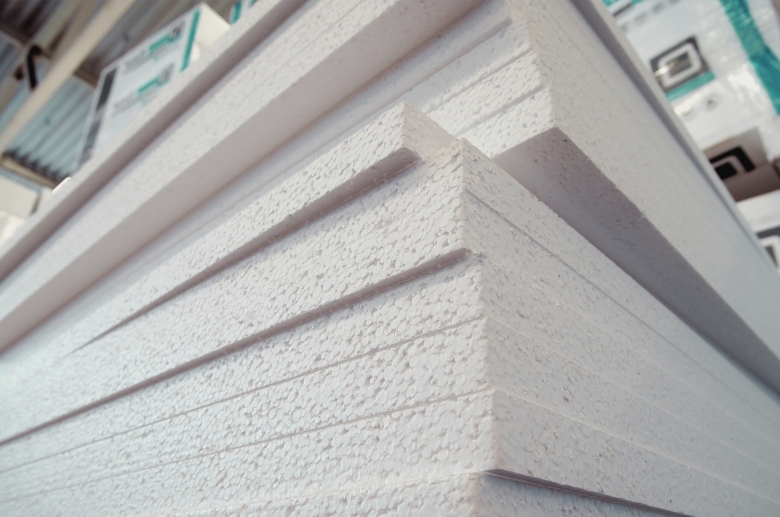
Polystyrene foam sheets usually come in DIY garage door insulation kits. These sheets can be used to insulate various garage door types.
The polystyrene insulation kit has rigid, precut insulation panels to fit the different garage door sections easily. These sheets are placed inside a single-layer garage door or between the steel layers.
Polystyrene usually has an R-value between R2 and R10, but the sheets come in varying thicknesses, so the R-value changes accordingly. You should select thicker polystyrene foam sheets for a higher R-rating (better at preventing heat transfer).
Pros
- Easy DIY Installation
- Durable
- Budget-friendly
- Quieter operation compared to uninsulated doors
Cons
- Lower energy efficiency than foam-injected polyurethane
Costs
On average, rigid foam insulation costs between $0.50 and $0.80 per square foot.
2. Polyurethane (Spray) Foam Insulation

Spray foam insulation gets its name from the method by which it is added to a garage door:
Polyurethane foam is injected between the steel layers of the garage door. It then expands and fills up each section of the door. Upon expansion, the polyurethane foam bonds to the inside of the door frame, increasing its structural integrity and making it more resistant to dents and damage.
Polyurethane foam insulation usually has an R-value between R10 and R17.5.
Pros
- Better insulation than polystyrene foam sheets
- Excellent soundproofing
- Great for extreme climates
- High R-value
- Fits easily in gaps and cracks
- Pest resistant
Cons
- More expensive than polystyrene foam sheets
- Requires professional installation
Costs
The average spray foam insulation cost is between $0.44 and $1.50 per square foot. Since it needs to be done by professionals, you must also add labor costs, which vary based on locality and job difficulty.
3. Fiberglass Insulation

Fiberglass insulation consists of innumerable air pockets. While these air pockets provide superior insulation, they make fiberglass susceptible to catching moisture. You should always add a vapor barrier to prevent moisture.
Fiberglass insulation is soft and flexible and comes in batts (single unrolled) or rolls (tightly packed). These batts are 3 1/2 to 12 inches thick and have an R-value between 2.9 and 3.8 per inch.
Fiberglass insulation batts are designed to fit garage door frames. However, sometimes, the standard-size fiberglass batts cannot completely cover the problematic corners of the garage door.
Pros
- DIY friendly
- Budget-friendly
- Natural fire retardant
- Natural sound-proofing
- Eco-friendly
Cons
- Can accumulate moisture
- Susceptible to mold and mildew
- Poor at preventing air leaks
Costs
The average cost of fiberglass insulation is between the range of $0.88 to $1.64 per square foot.
4. Radiant Barriers and Reflective Insulation Systems
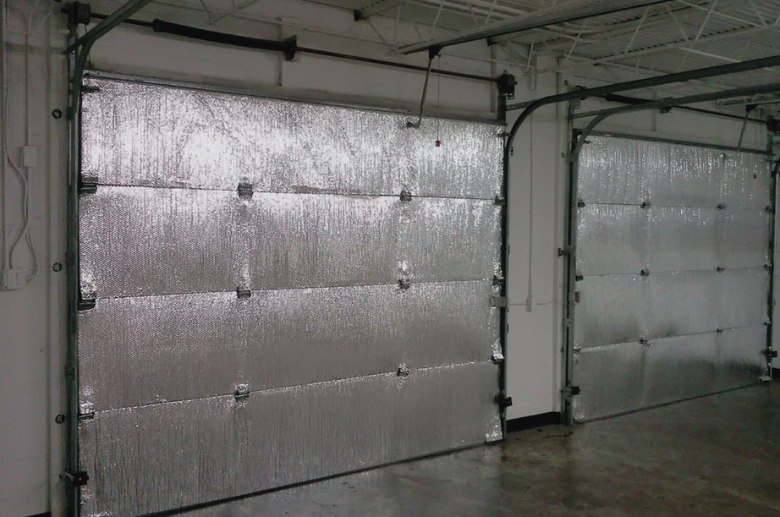
A radiant barrier and reflective insulation system (also called foil insulation) comprises kraft paper, polyethylene bubbles, or a combination of substrate materials wrapped in aluminum foil (reflective barrier).
Their R-value does not measure the effectiveness of such systems. These systems reflect radiant heat coming from the roof and the sun. However, the reflective surface should face an air space for the system to work effectively. Therefore, it must be installed so that dust doesn’t accumulate on the reflective surface.
Pros
- Reflects heat
- Lower cooling costs
Cons
- Not effective in colder regions
- Requires professional installation for best results
Costs
The average cost of a reflective insulation system is between $1.10 and $0.25 per square foot. You must also pay for labor, which varies based on your locality and the job’s difficulty, adding to the insulation cost.
5. Cellulose Insulation

Cellulose is a fiber insulation that you can add to your garage walls and unfinished attic floors. It is made up of recycled paper treated with chemicals that make it fire-resistant and pest-repellent. Cellulose insulation has R-values between R-3.1 and R-3.8 per inch.
Cellulose is installed in the following ways:
- Blown as loose-fill insulation – best for attic cavities.
- Dense pack cellulose – usually used in existing construction.
- Wet-applied spray cellulose – added to new constructions before putting up drywall.
Pros
- Most eco-friendly commercial insulation
- Fire-resistant
- Pes-resistant
Cons
- More expensive than fiberglass
- Sags and settles over time, becoming less effective
- Absorbs moisture that leads to mold and mildew
Costs
On average, cellulose insulation costs between $1.80 and $2.30 per square foot. However, you must also factor in the labor, which varies depending on your local labor cost and the difficulty of the space you need to insulate.
6. Mineral Wool Insulation
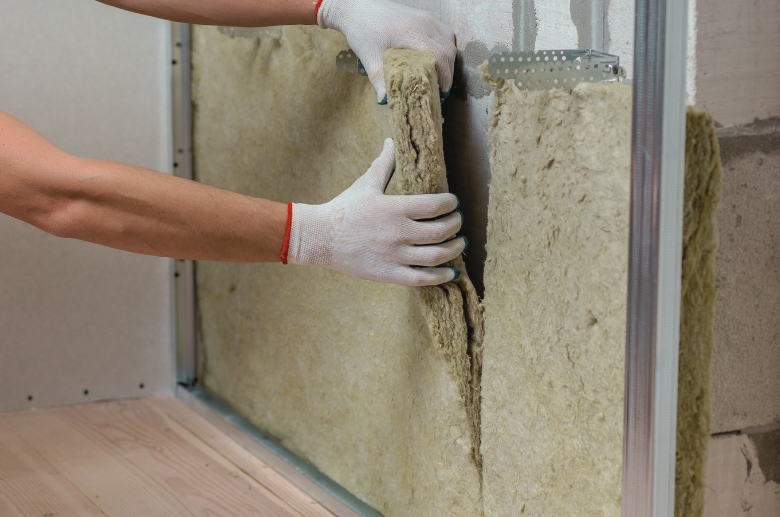
Mineral wool insulation is made from stone, silica, and other natural minerals. It is used for garage walls and floors, roofs, attics, etc., and has an R-value of R-4.2 per inch.
Mineral wool insulation is made by heating the raw materials to a high temperature. Once the material is melted, it is spun into fibers formed into insulation slabs, rolls, pipe sections, and loose wool.
The most common mineral wool insulations are:
- Stone wool – made from volcanic rock
- Glass wool/Glass fiber – made from silica or glass cullet.
Depending on its application, mineral wool insulation comes in various thicknesses, from 25mm to 250mm.
Pros
- Effective thermal insulation
- Noise-reduction and sound-absorption
- Non-combustible
- Moisture resistant
- Durable
Cons
- Inhaled slivers of mineral wool can cause lung disease
Costs
Mineral wool costs between $1.50 and $2.50 per square foot on average. However, you must also factor in the labor cost, which varies depending on your local labor cost and the difficulty of the space you need to insulate.
Is It Worth It to Buy an Insulated Garage Door?
When choosing between an insulated, non-insulated, and semi-insulated garage door, you must consider your budget, what features you want in your garage door, and how you want to use your garage.
To help you in your decision, let’s discuss each of these options:
Non-Insulated
Non-insulated steel garage doors, also called pan doors, are hollow inside. These doors are single-layer constructed doors and usually come in three grades:
24 gauge – is thick and rigid
25 gauge – is the standard
26 gauge (builder grade) – is light and less durable
Non-insulated doors are the cheapest ($500 – $1,500) because they don’t have any insulation. These doors are best for unattached garages used only for parking and storing items that don’t need temperature control.
These garage doors are light, durable, and easy to operate. However, they are susceptible to dents and damage, so expect them to last 10-20 years.
Connect With A Garage Expert
Connect with local experts, Compare quotes, Get the best price.
Semi-Insulated (Vinyl Back)
Semi-insulated or vinyl-backed garage doors are double-layer constructed doors. They are precisely like pan doors. The only difference is that these doors have an insulation foam core with vinyl backing instead of being hollow.
These doors are more durable than single-layer ones and last 15-25 years. They also have some insulation, with an R-value of R-6 to R-7.
Semi-insulated garage doors offer the best of both worlds. These doors are not as expensive ($800 – $2,000) as steel back doors but provide enough insulation for most cases, especially if you live in a region that doesn’t get too hot or cold.
Fully Insulated (Steel Back)
Fully insulated or steel-back garage doors are triple-layer constructed doors. They have steel on the outside and the inside, with insulation in the middle.
These doors come in different thicknesses; the higher the thickness, the higher the R-value (i.e., lesser heat loss). Thin steel back doors usually have an R-value of 8-10, whereas steel back doors have an R-value of 12.9.
Even though these doors are pretty expensive ($1,000 – $3,500+), they offer excellent insulation, require less maintenance, and last for more than 25 years. These doors are great if you want a comfortable environment inside your garage for different activities and want your garage door to last.
How Much Does an Insulated Garage Door Cost?
The following table compares the costs of different garage door insulations:
| Garage Insulation | Average Cost | DIY |
| Polystyrene (Rigid) Foam Sheets | $0.40 to $0.75 per sq ft | Yes |
| Polyurethane (Spray) Foam | $0.44 to $1.50 per sq ft | Yes (but professional insulation is recommended) |
| Fiberglass Insulation | $0.88 to $1.64 per sq ft | Yes |
| Radiant Barriers and Reflective Insulation Systems | $1.10 to $0.25 per sq ft | No |
| Cellulose Insulation | $1.80 to $2.30 per sq ft | Yes |
| Mineral Wool Insulation | $1.40 to $2.10 per sq ft | Yes |
Should I Insulate the Garage Myself?
If you plan to insulate your garage, you have two options. You can choose the DIY route or hire a professional garage door service to do the job for you.
Hiring professional services is the best option if you are not handy with tools, want to ensure an excellent job, and are willing to spend money to cover the labor cost. They’re experienced, have all the necessary tools, and ensure everything is done correctly. However, make sure the garage services company is certified, has been serving for a good few years, and has good reviews.
Note: Professional insulation is preferred for spray foam insulation and radiant barriers.
Final Thoughts
By now, you’ll have a pretty good idea of what garage insulation will be best for your needs. Whether you plan to insulate your garage and save on labor costs or let the professionals handle the job is up to you. If you plan to go the DIY route, choose DIY-friendly insulation (e.g., rigid foam insulation), wear protective gear, and follow all the steps in the guide to ensure accurate installation.
Hire a certified garage door installation service if you want peace of mind and professional installation.

